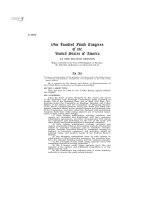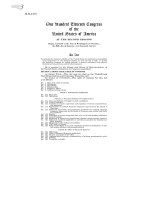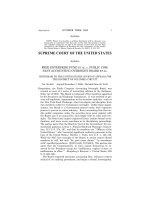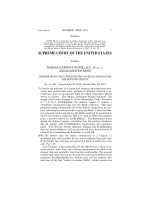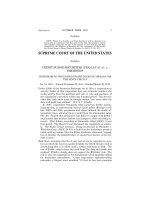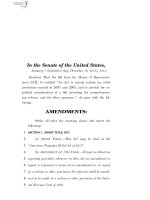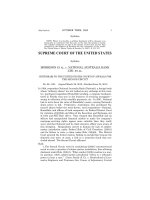Implementation of New Accounting,,Standards of the United States Washington _part1 potx
Bạn đang xem bản rút gọn của tài liệu. Xem và tải ngay bản đầy đủ của tài liệu tại đây (871.28 KB, 11 trang )
This is trial version
www.adultpdf.com
This is trial version
www.adultpdf.com
This is trial version
www.adultpdf.com
Comptroller General
of the United States
Washington, D.C. 20648
B-282041
March 31,1999
The President,of the Senate
The Speaker of the House of Representatives
Implementation of important legislative reforms is underway to promote greater
accountability in managing the finances of our national government.
These reforms include
requirements for annual audited financial statements for 24 major departments and agencies
as well as preparation of financial statements of the US. government, ,which we are,required
to’audit. Our report is included in the accompanying Treasury publication, 1998 F’inancial
Renort of.the United States Government. This letter highlighm our conclusions.
In summary, significant fmancial systems weaknesses, problems with fundamental.
recordkeeping and financial reporting, incomplete documentation, and weak internal
controls, including computer dontrols, continue to prevent the government from accurately
reporting a significant portion of its assets, liabilities, and costs. These deficiencies affect the
reliability of the financial statements and much of the related information in the financial
report, as well as the underlying financial information.
They also affect the government’s
ability to accurately measure the full cost and financial performance of programs and manage
its operations. Major problems included the federal government’s inability to
9 properly account for and report (1) billions of dollars of property, equipment, materials,
and supplies arid.(2) certain stewardship assets;
l properly ‘estimate the cost of most major federal credit programs and the related loans
receivable andkxn guarantee liabilities;
l
estimate and reliably report material amounts of environmental a&disposal liabilities
and related costs,
l determine the proper amount of various reported liabilities, including postretirement
health benefits for military employees, accounts payable, and other liabilities;
l
accurately report major portions of the net cost of government operations;
l
determine the full extent of improper payments that occur in major programs and that are
estimated to involve billions of dollars annuahy;
l ensure that all disbursements are properly recorded; and
J,.
GAO/AIMD-99-130
This is trial version
www.adultpdf.com
B-282041
l
properly prepare the federal government’s financial statements, including balancing the
statements, accounting for billions of dollars of transactions between governmental
entities, and properly and consistently compiling the information in the financial
statements.
These deficiencies prevented us from being able to form an opinion on the reliability’of the
financial statements and represent material weaknesses in internal control.
The executive branch recognizes the extent and severity of the financial management
deficiencies and that addressing them will require concerted improvement efforts across
government. The administration has set goals for completing timely audits and receiving
unqualified opinions for individual agencies as well as the financial statements of the U.S.
government. Annual financial audits represent an important means to assure continued
progress in connection with improving federal financial management.
While obtaining unqualified “clean” audit opinions on federal financialstatements is an
important objective, dt is not an end in and of itself. The key is to take steps to continuously
‘.
improve:inte~al c~~troi~.,and;Griderlying~financi~ and management,infoi.mation systems as a
means to a&&e accountability,~ increase the~&conomy; improve the, effmiency, ,$nd enhance
the effectiveness of governments These systemsmust, generate timely, accurate, and useful
I, information on an ongoing ,basis; not just as of the end of the fiscal year.
I,
,. ‘,”
,.( .
‘, 3,.
We appreciate the eoo$eration &d a&i&nce we received from the Chief Financial Officers
and InspectorsGeneral throughout’government, as well as Department of the Treasury and
‘/ :
Office of Management,and Budget officials, incarrying out our responsibility to audit the
government?s’fina&al statements: We look forward to continuing to w.ork with these
officials and the.Congress to achieve the goals and objectives associated with financial
management reform.
Our report was prepared under the direction of Gene L. Dodaro; Assistant Comptroller
General, and Robert F Dacey, Pirector, .Consolidated Au,dit and Computer Security Issues. If
yo
have any questions, please contact me,on (2.02) 512~5500 or them on (202) 512-3317.
,i.
,, .’
t b
‘, j
Qgyy? ” ),,> ‘, s
David M. Walker
Comptroller General.
of the United States
:
:
(919338)
Page 2 GAO/AIMD-99-130
This is trial version
www.adultpdf.com
Contents
A Message from the Secretary of the Treasury.
;
Management’s Discussion and Analysis
General Accounting Office Report
Comptroller General’s Statement
Auditor’sReport :
Financial Statements
Statement of Operations and Changes in Net Position.
Statement of Net Cost.
Balance Sheet
Stewardship Information (Unaudited)
Stewardship Assets:
National Defense Assets.
Stewardship Land.
HeritageAssets ;
Stewardship Responsibilities:
Social Security
Medicare
Railroad Retirement
BlackLungBenefits
Unemployment Insurance
Current Services Assessment
Notes to the Financial Statements
Note
1 -
Summary of Significant Accounting Policies.
:
Note2-CashandOtherMonetaryAssets
Note3-LoanPrograms
Note 4 - Taxes Receivable t
Note 5 - Inventories and Related Property
Note 6 - Property, Plant and Equipment
Note 7 -Other Assets
Note 8 - Accounts Payable
Note9-FederalDebtSecuritiesHeldbythePublic
Note 10 - Federal Employee and Veteran Benefits Payable .
Note 11 - Environmental Liabilities
Note 12-BenefitsDueandPayable
.;
Note 13 - Other Liabilities
Note 14 - Prior Period Adjustments
.
Note 15 - Commitments and Contingencies
Note 16 - Unreconciled Transactions Affecting the Change in Net Position
1
3
15
19
41
42
42
49
52
54
56
57
58
59
60
61
63
65
66
67
67
68
69
69
69
72
75
75
76
76
77
78
Note 17 - Dedicated Collections . . . . . . . . . . .‘: . . . . . . . . . . . . . . . . . . . . . . . . . . . . . . . . . .
78
Note 18 - Indian Trust Funds . . . . . . . . . . . . . . . . . . . . . . . . . . . . . . . . . . . . . . . . . . . . . . . . . .
81
Supplemental Information (Unaudited)
Net Cost Detail . . . . . . . . . . . . . . . . . . . . . . . . . . . . . . . . . . . . . . . . . . . . . . . . . . . . . . . . . . . . . . 83
Reconciliation of the Excess of Net Cost Over Revenue
to the Unified Budget Surplus . . . . . . . . . . . . . . . . . . . . . . . . . . . . . . . . . . . . . . . . . . . . . . . .
89
Appendix
List of Significant U.S. Government Entities Included
and Entities Excluded from these Financial Statements . . . . . . . . . . . . . . . . . . . . . . . . . . . .
91
This is trial version
www.adultpdf.com
r
i
This is trial version
www.adultpdf.com
A MESSAGE FROM THE
SECRETARY OF THE TREASURY
Attached is the fiscal year 1998 Financial Report of the United States Government,
formerly known as the Consolidated Financial Statements of the U.S. Government.
The Administration initiated the development of this fmancial report in order to create
what we believe will be a useful management tool for policy-makers and a source of
useful information for the public. Last year, for the first time, the United States
Government prepared comprehensive financial statements covering all of its myriad
activities and subjected them to audit. This year, for the second time, the
Administration presents the Financial Report of the United States Govermnent,
including audited financial statements that cover the Executive Branch, as well as
parts of the Legislative and Judicial branches of the United States Government.
The publication of this second annual fmancial report represents one component of
the Clinton Administration’s continuing efforts to improve the management and
effr
F
iency of the United States Gove rnment. In 1994, the Administration supported
the Xjovemment Management Reform%ct,,&hich mandated the issuance of these
audibed financial statements. The Administration has supported the Federal
Accounting Standards Advisory Board in creating the accounting standards that form
the basis for the fmancial statements included in this financial report.
These accounting standards generally are based on the accrual basis of accounting,
which differs from the cash basis of accounting used in the reporting of budget results.
The principal differences between these,two accounting methods pertain to the timing
of the measurement and recognition of revenues and expenses and the inclusion of a
presentation of assets and liabilities. Each method is a useful tool for looking at the
government’s operations for different purposes.
A great deal of work has been done, but the development of this new method of re-
porting is an immense task and a great deal of additional effort will be necessary to
create and implement an entirely new system of reporting on the operations of the
U.S. Government. We are working hard toward that goal to complement our existing
budget reporting. The audit report from the General Accounting Office (GAO) dis-
cusses many areas in which the reliability of the current financial statements must be
enhanced and improved. As a result, the GAO was unable to render an opinion on
these statements. The Administration is committed to continuing its work with the
GAO, Federal agencies, and other interested parties to achieve the President’s goal of
receiving an unqualified opinion from the GAO on the Financial Report of the United
States Government. We believe that the publication of this financial report is an im-
portant step in providing the American public with useful information about their gov-
ernment’s assets, liabilities and operations.
Robert E. Rubin
This is trial version
www.adultpdf.com
I
,‘I, 2
DISCUSSION AND ANALYSIS
blank Page
,
,
‘,
’
; /’ ;,
,
,r:
:I I,.
’
‘,
’
.‘
2 ,”
.:
.1
:
.,
:
, /., .,;
This is trial version
www.adultpdf.com
DISCUSSION AND ANALYSIS
3
,
l!inancial, Report ,of the
.’
United,., States Goiern’ment, Fiscal 1998
Reform Act, which requires annual audit of these statements. The Ad-
timanciai statements for the 24 major
ministration’s accomplishments are
agencies andfor the U.S. Govern-
presented later in this discussion and
ment as a whole.
analysis.
No other entity in the world com-
The Administration appreciates the
The Administration is committed
pares in size and scope to the U.S.
work of the GAO in subjecting these
to ‘improving the reliability of the fi-
Government, which has continuing f
mancial statements to audit and
nancial information to achieve its
responsibilities for the general wel-
looks forward to working with the goaiof an
unqualified oPhi,On on the
fare of its citizens and for national de- GAO, Federalagencies and other in- financial statements of individual
fense. The U.S. Government’s com- terested parties in its continuing effort agencies and the U.S. Government.
prehensive,financial report, prepared
to improve the reliability of Federal
financial information. The effort to
The Administration’s
goals
for indi-
in accordance with Federal account-
vidual agencies are reflected in the
ing standards, includes all of its activ-
produce a comprehensive and reliable
Federal ,Fmancial Management Status
ities.
set of financial statements for the U.S.
Effective management of the U.S.
‘.
:
Report and Five-Year Pl,an issued by
the OMB,and the Governmentwide
’ Government has been hampered,by a ., Chief Financial Officers (CFOs)
,
lack @comprehensive financial in-
‘The /Administration is
Council. That documentreflects the
formation. The Administration re- dates by which agencies are expected
mains committed to providing reli-
L : committed to
improving, the reliability
to achieve the Administration’sobjec-
able, mformation about the financial
,I-: of the, financial 1
tives. ,
positionof the U.S. Government, the
infoimation ; f 2’
The ^accom anying Financial Re-
cost of its operations, and,the financ- ,” i .Z 1;: + ;
:: ,:
port is requi ed by 31 Utiited States
,ing sources used to, fund operations.
I ._. ,,
/ I
9
Code 331(e) I) and consists ;bf Man-
Sudfi’i&&-hati?fi wil~,~ltima&ly , ‘,L $:I ‘: I, ,( ‘,
agement’sDiscussion and Analysis
prove~extreinely helpful t0,p01~’
Govement’ which began in’i99; is
(MD&A); a Statement of.Operations‘
icy-makers ‘&id the public
4
,Tb’ ,iij@ve .the quality of ,fmanci,al
ongoing,a+ improvements ,$e
and’changes in Net Position, a: State-
clearly necessary: Because of current
ment ofI%t ‘Cost, .a Balance’ Sheet,
information, in 1990 ,the Office of 1.
lmitations‘that are discussed in
r;t~~ar~~~ip’Inf~rnati~n, Notes to
Management and Budget (OMBL
GAO'S
Report, the GAO
is
unable to
the Financial Statements,.and, Supple-’
Treasury,- and the U.S. General Ac-
render an opinion on these financial
counting Office (GAO) established
statements. The.challenges invoiied
mental Information. Each section is
preceded by a description of the sec-
the Federal Accounting Standards in developing timely, reliable, and tion’s contents. The Supplemental In-
Advisory Board (FASAB) to develop
comprehensive financial information formation section describes the
major
accounting standards for the U.S.
should not, however, obscurethe fu
nc tons of the U.S. Government.
t*
Government. In 1994, the President P
ro
gr
ess that has been made or the’in-
signed the Government Management
sights provided”by preparation and
J
This is trial version
www.adultpdf.com
.4
DISCUSSION AND ANALYSIS
i
i
report on the U.S., Government’s 1998 fmancial statements.
,.L
., ;:.
.:
i
I ,,:
‘ :,
The MD&A, explains the Federal reporting entity, the basis of accounting
used to prepare these financial statements, and presents selected financial
and economic informationintended to assist readers in their assessment of
the US. Government’s financial operations and status. It also summarizes fir,
nancial management initiatives designed to continue improving the reliabil-
itv of the fmancial statements and to address the issues identified in GAO’s
Coverage
the ‘Appendix. Information from the
legislative andjudicial branches is
they are privately owned. The Fed-
.limited because those entities are not
era1 Reserve System is also
excluded because monetary policy
The financial statements cover the
required to prepare comprehensive
is conducted separately i?om’and
executive branch, aswell as parts of
.financial statements. In addition,
independently of the other central
tl-mlegislative and: judicial-branches
Govemment$ponsored enterprises Government functions.
of the U.S. Government. A list of the
significant entities included in these
(such as Federal Home Loan Banks
and the Federal Natiorral. Mortgage
,.
. .
financial stateiments is,jncluded,in
‘iAssociation) are excluded because
::.:. ’
,, ‘.
:,
: :,’ ,, ,; ,; .,;
Accounting Standaids -”
The accounting standards used in
the preparation of the accompanying
financial statements Were developed
by the Federal~Accounting Standards
Advisory Board (FASAB); approved
by Treasury, OMB and GAO as’the
FASAB’principals;‘and‘issued by
OMB and,GAO. The standards are
tailored to the:U:S.,Government’s
unique~characterj’stics and sce’cial
needs: For, example, land not use‘d in
U.S.‘Govermnent operations.(stew-
ardShip.Iland):and: .we.apon systems
and support mope&y ,u+di.&the~,p,er- ,,_
formance’ Qf:mi!itary.,mssions, and
vessels held,as &t of $he~ational
“, ‘,, ,,
Defense ; Reserve E leet (national .’ de-
fense @,ets)are repoited~+heSte,$~
ardsh$p .Tn,f~~~~~~pe sectipn rather
than on the Balance Sheet.
The financial statements of the
U.S. Govemment’are Prepared gen;
erally’on the accrual basis of account-
ing. Under the accrual basis; transac-
tions are,reported when the events
giving rise to the transactions occur,’
rather than when cash is received or
paid (cash basis). By contrast, Fed-
eral budgetary reporting is generally
on the cash ,basis in accordance w.ith
accepted budget concepts and poli-
cies.
The m,?st’significantdifference.be-
tween these’two. bases involves the
timing of recognition and measure-
ment of revenues and costs. For ex-
ample, Federal accounting standards.
require: recognition ‘of ‘liabilities for
costs related to environmental
cleanupwhen the events resulting in
such costs, occur. By%ontrast~‘Ybudget
concepts~ and policies require the rec-
ognition of such costs at,& time
~pajmentis~made. The.effects‘ofthese-’
differences are reflected inthe “Rec-
onciliation of the Excess of Net Cost
over. Revenue to the ,Unified Budget
Surplnsi’J dhich is $resented, in the
SupIjlemental Infot&ation &ti,on of
this Financial Report.
In fiscal $998; theie was a budget
surplus of $69.2 billion. The excess
of net cost over revenue figure con-
tained in these financial statements
for fiscal 1998 is $133.8 billion. This
difference is attributable. to factors.
discussed immediately above. The
primary components of the differ-
ence that have been identified are
increases in accrued veterancom-
pensation benefits, $109.4 billion; in-
creases in actuarial expenses for Fed-<
era1 employees and military pensions
and health benefits, $39.8 billion;
and an increase in environmental lia-
bilities, $12.8 billion.
’
This Financial Report does not in:
elude information on natural re-
sources (depletable resources, ‘such
as mineral debosits,and petroleum or,
renewable resources, such ,as timber)
because standards have not yet been‘
developed forrecogni+ng,aird mea-
suring these assets.‘,
,
l$trally, a thorough assessment of’
the ,U.S. Government’s financial stai
tus should recognize its”sovereign
powers to raise revenue and regulate
commerce. These powers are not re-
flected in the accompanying state-
ments; but should be considered in a
cornprehensive assessment of the
U.S. Government’s ,overall financial
condition.
-
:
This is trial version
www.adultpdf.com
